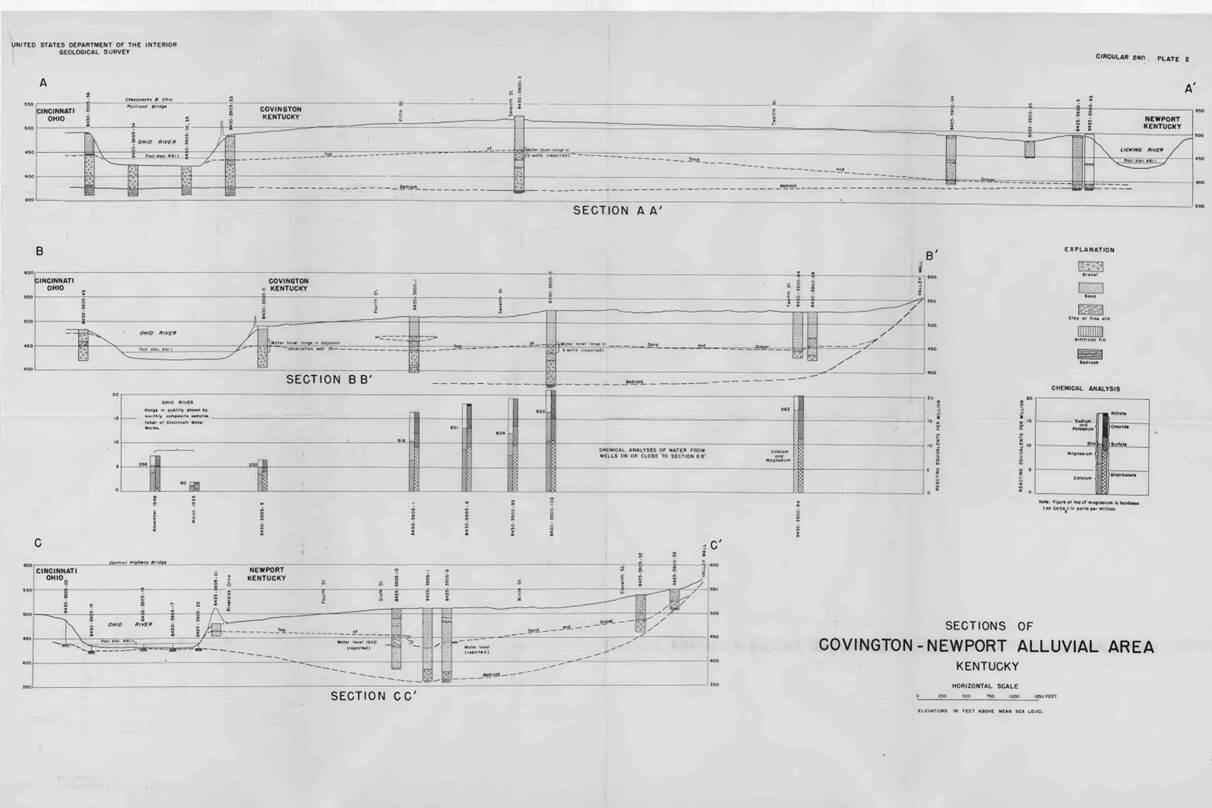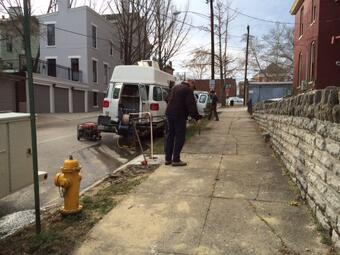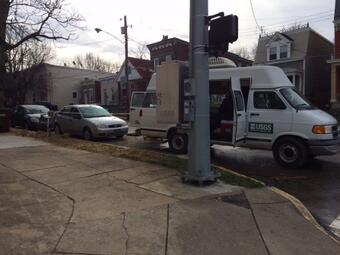Urban Hydrology Stormwater Management Active
USGS staff making an e-tape measurement Bellevue well
USGS staff measuring the Ludlow well
Drilling new well - Sanitation District No 1
Hydrogeologic reconnaissance, well inventory, and site-specific aquifer test data are needed in order for managers
to assess whether use of stormwater injection wells is technically or economically feasible for Class V underground
injection, file necessary permit applications, and begin the process of developing the necessary engineering design
specifications. Sanitation District No 1 requested that the USGS conduct scientific activities capable of supplying the utility with the needed hydrogeologic information.
Hydrogeologic reconnaissance, well inventory, and site-specific aquifer test data are needed in order for Sanitation District No 1 managers to assess whether use of stormwater injection wells is technically or economically feasible for Class V underground injection and begin the process of developing the necessary engineering design specifications.
Project Objectives
The objectives of this project will be accomplished through four major approaches/tasks
- complete a basic well inventory within the service area, particularly the combined sewer area
- assess the structural integrity of identified wells
- collect basic hydrologic characteristics
- conduct specific capacity tests on accessible and applicable wells
- compile existing information into a bibliographic reference
- write a USGS Open-file report to present the findings
Current Knowledge
- Groundwater use in Northern KY consists of little to none
- Alluvial aquifer in Northern KY productive with thick sand and gravel layers, but interspersed with clay lenses
- Original plan was to inject stormwater into bedrock
- Performed well inventory to locate bedrock wells to test, found none
- Found only one suitable sand and gravel well– Glier’s
- Preliminary injection test at Glier’s
- 50 gpm for 20 minute intervals
- Hydraulic conductivity equaled17 ft/day, promising enough for further testing

Drilled 3 wells for further aquifer testing
- Recently sampled for QW, found groundwater quality to be within standards of clean drinking water
- Sanitation District No 1 Currently collecting stormwater for QW


Technological or Other Hurdles
- Potential fouling of screens in unsaturated zone may cause short life span for test wells
- Collapse or filling in of Covington well
Related Work
- currently collects continuous QW data in streams for SD1
- Sediment Lab processes samples to calculate suspended sediment concentrations in stormwater runoff

Take-Aways/Final Thoughts
- Great opportunity to provide data that has not existed until now, to inform the USEPA Region 4 and other cooperators about the potential for stormwater injection wells throughout the region
- Good chance to characterize this part of the Ohio River alluvial aquifer, since little to no current data exist

Below are partners associated with this project.
Hydrogeologic reconnaissance, well inventory, and site-specific aquifer test data are needed in order for managers
to assess whether use of stormwater injection wells is technically or economically feasible for Class V underground
injection, file necessary permit applications, and begin the process of developing the necessary engineering design
specifications. Sanitation District No 1 requested that the USGS conduct scientific activities capable of supplying the utility with the needed hydrogeologic information.
Hydrogeologic reconnaissance, well inventory, and site-specific aquifer test data are needed in order for Sanitation District No 1 managers to assess whether use of stormwater injection wells is technically or economically feasible for Class V underground injection and begin the process of developing the necessary engineering design specifications.
Project Objectives
The objectives of this project will be accomplished through four major approaches/tasks
- complete a basic well inventory within the service area, particularly the combined sewer area
- assess the structural integrity of identified wells
- collect basic hydrologic characteristics
- conduct specific capacity tests on accessible and applicable wells
- compile existing information into a bibliographic reference
- write a USGS Open-file report to present the findings
Current Knowledge
- Groundwater use in Northern KY consists of little to none
- Alluvial aquifer in Northern KY productive with thick sand and gravel layers, but interspersed with clay lenses
- Original plan was to inject stormwater into bedrock
- Performed well inventory to locate bedrock wells to test, found none
- Found only one suitable sand and gravel well– Glier’s
- Preliminary injection test at Glier’s
- 50 gpm for 20 minute intervals
- Hydraulic conductivity equaled17 ft/day, promising enough for further testing

Drilled 3 wells for further aquifer testing
- Recently sampled for QW, found groundwater quality to be within standards of clean drinking water
- Sanitation District No 1 Currently collecting stormwater for QW


Technological or Other Hurdles
- Potential fouling of screens in unsaturated zone may cause short life span for test wells
- Collapse or filling in of Covington well
Related Work
- currently collects continuous QW data in streams for SD1
- Sediment Lab processes samples to calculate suspended sediment concentrations in stormwater runoff

Take-Aways/Final Thoughts
- Great opportunity to provide data that has not existed until now, to inform the USEPA Region 4 and other cooperators about the potential for stormwater injection wells throughout the region
- Good chance to characterize this part of the Ohio River alluvial aquifer, since little to no current data exist

Below are partners associated with this project.

